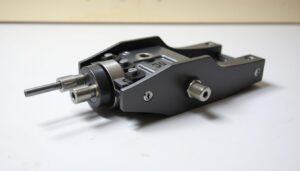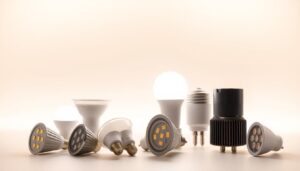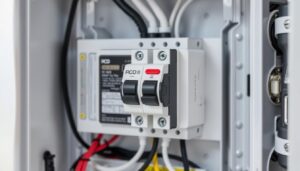Are you looking to create a productive workspace in your garden office, but unsure about how to provide a safe and reliable electrical supply?
Extending your home’s ring main to your garden office is a viable solution, but it requires careful planning and execution to ensure safety and compliance with UK regulations.
This comprehensive guide will walk you through the process, covering everything from understanding electrical requirements to the final installation and testing of your garden office power supply.
Key Takeaways
- Understand the electrical requirements for your garden office.
- Learn how to safely extend your home’s ring main.
- Discover when to call in a qualified electrician.
- Ensure compliance with UK electrical regulations.
- Test and verify your garden office power supply.
Understanding Garden Office Electrical Requirements
When setting up a garden office, it’s crucial to understand the electrical requirements to ensure a safe and functional workspace. A well-planned electrical setup is essential for powering your equipment, lighting, and heating systems.
What Is a Ring Main and Why Extend It?
A ring main is a type of electrical circuit that provides power to multiple sockets around your home. Extending this circuit to your garden office can provide the necessary power for your workspace. A 32A 30mA RCD Protected Supply is generally recommended for garden buildings to ensure adequate power and safety.
Extending your ring main to your garden office can be a cost-effective way to provide power, but it requires careful planning to ensure it meets your electrical needs.
Power Needs for a Typical Garden Office
A typical garden office requires sufficient power for computers, lighting, heating, and potentially other equipment like printers or small appliances. Most garden offices benefit from having at least 4-6 sockets strategically placed around the space to accommodate various devices and avoid overloading.
| Equipment | Power Requirement |
|---|---|
| Computers and Monitors | 500-1000 Watts |
| Lighting | 100-500 Watts |
| Heating Systems | 1000-2000 Watts |
When planning your electrical design, consider future needs as well as current requirements to avoid limitations later. A 6mm SWA Cable is typically sufficient for most garden office setups, pending the length of the cable run.
Safety and Legal Considerations
When planning to supply electricity to your garden office, it’s crucial to understand the safety and legal considerations involved. Extending your ring main to a garden office is not a task to be taken lightly, and there are several factors you must consider to ensure the job is done safely and correctly.
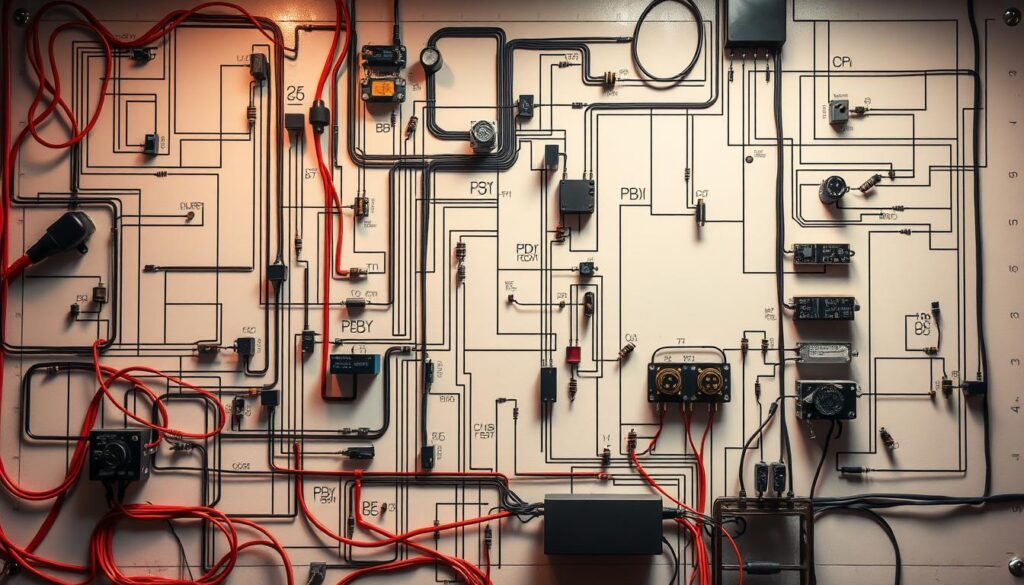
Part P Building Regulations in the UK
The UK’s Part P Building Regulations are in place to ensure that electrical work is carried out to a safe standard. “Electrical work in your home or garden office must be done to a standard that prevents danger or injury,” as stated by the UK Government’s guidelines on electrical safety. You must comply with these regulations when extending your ring main. This includes ensuring that any new electrical circuit is installed correctly and that the work is inspected and tested by a qualified electrician.
To comply with Part P, you would need to either be a registered competent person or have your work inspected by a building control body. This regulation is crucial for your safety and the safety of others using the garden office.
When to Call a Professional Electrician
Supplying electricity from your house to your shed is something that you should never attempt yourself unless you are a qualified electrician. There are several reasons for this, including:
- Connecting a new circuit to your main consumer unit/fuse box should always be done by a qualified electrician.
- A professional electrician is required for calculating the correct cable specifications, ensuring proper earthing, and installing RCDs.
- While you may be able to handle some aspects of the project yourself, the final connections and testing must be completed by a certified professional.
By hiring a professional electrician, you ensure that your garden office electrical supply is safe, reliable, and compliant with all relevant regulations, saving you time and potential problems in the future. A professional will assess your existing electrical setup to determine the best approach for your specific situation, ensuring that the job is done efficiently and to a high standard.
Planning Your Electrical Extension Project
When planning to extend your ring main to a garden office, several key factors must be considered to ensure a safe and efficient electrical supply. A well-planned project is crucial for meeting your electrical needs without compromising safety.
Assessing Distance and Route from House to Garden Office
Assessing the distance and route from your house to the garden office is a critical step. You need to determine the most practical and safe route for your electrical cable. The distance will also impact the cable size required to minimize volt drop. For longer distances, typically over 20 meters, you may need to increase the cable size to compensate for voltage drop, ensuring your garden office receives adequate power.
Calculating Load Requirements and Voltage Drop
Calculating the total electrical load for your garden office is essential. You should add up the wattage of all equipment you plan to use simultaneously, including computers, lighting, heating, and any other appliances. This calculation will help determine the appropriate cable size and circuit protection. A qualified electrician can advise whether you could run a new circuit or extend an existing one based on your load requirements and distance, ensuring a safe and efficient electrical supply in the most practical way.
- Calculating the total electrical load for your garden office is essential for determining the appropriate cable size and circuit protection.
- Add up the wattage of all equipment you plan to use simultaneously, including computers, lighting, heating, and any other appliances.
- Voltage drop becomes significant over longer distances and must be calculated to ensure your garden office receives adequate power.
Essential Materials and Tools Needed
To safely extend your ring main to a garden office, you’ll need to assemble the necessary materials and tools. This ensures a reliable and safe electrical supply to your garden building.
Selecting the Right Armoured Cable (SWA)
Choosing the correct armoured cable is crucial for a safe and durable electrical connection to your garden office. Armoured cable, or SWA (Steel Wire Armoured) cable, is designed to withstand outdoor conditions, including moisture and mechanical damage.
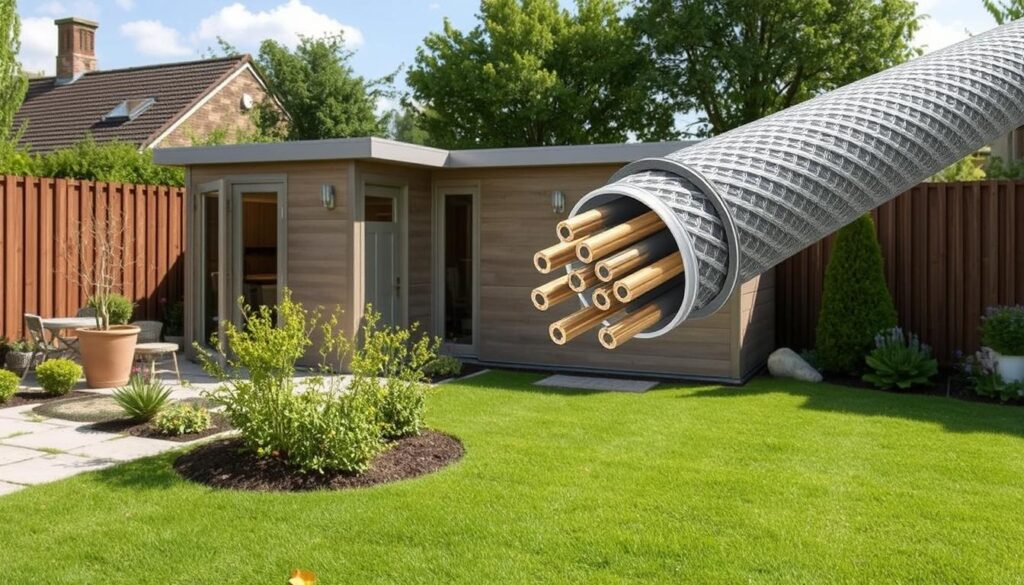
Consumer Units and RCDs for Garden Buildings
A consumer unit is essential for distributing power within your garden office. It’s recommended to use a 32A 30mA RCD Protected Supply for garden buildings to ensure safety against electrical shock.
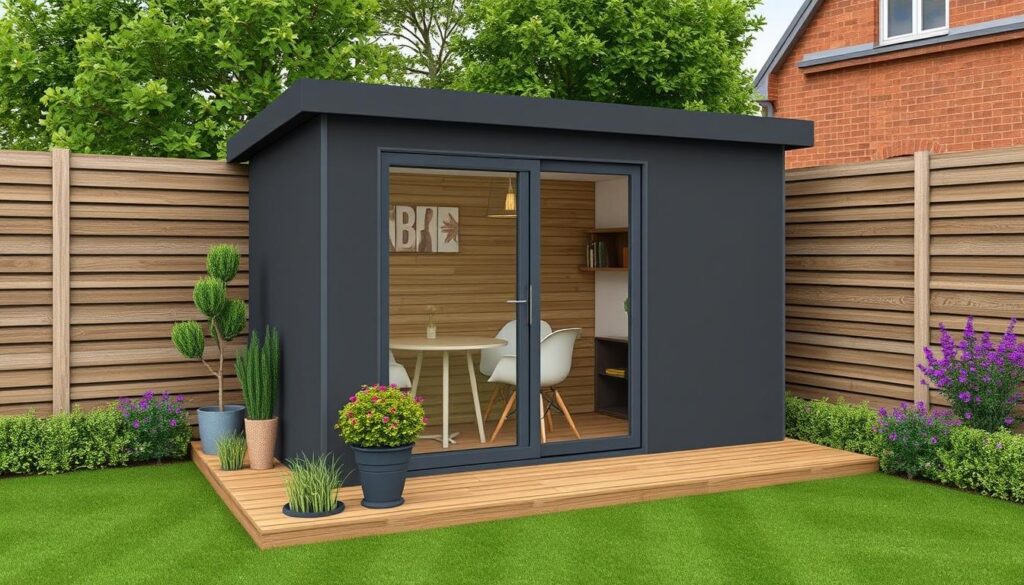
Additional Tools and Supplies
You’ll need various tools and supplies to complete the installation. These include:
- Cable glands specifically designed for SWA cable
- Waterproof junction boxes for outdoor connections
- Socket outlets, light switches, and mounting boxes for internal wiring
- Cable cutters, wire strippers, screwdrivers, SWA gland tools, and a voltage tester
- Weatherproof sealing materials and conduit for protecting cables
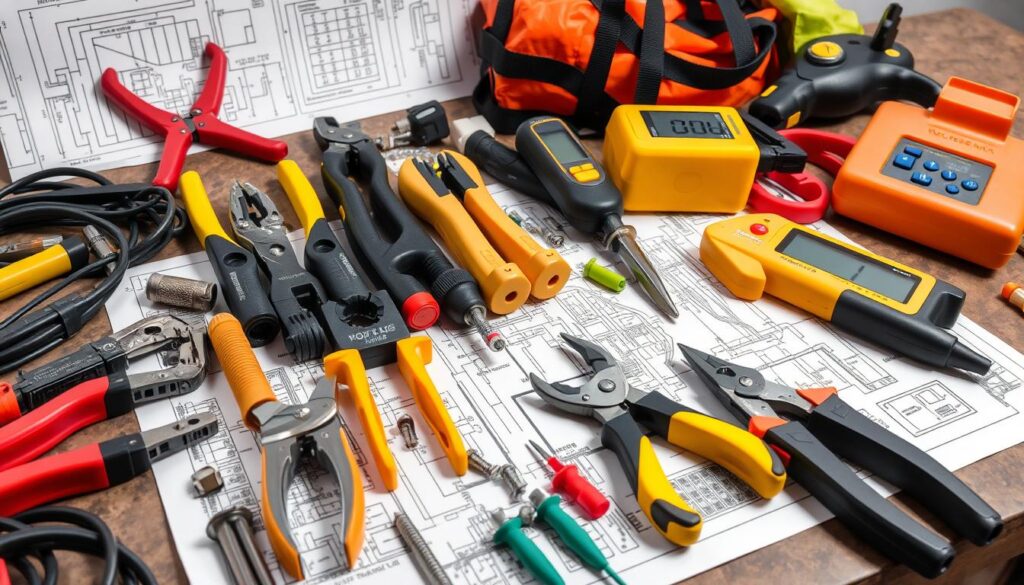
How to Extend Ring Main to Garden Office: Step-by-Step Guide
To supply your garden office with electricity, you’ll need to extend your home’s ring main circuit. This process involves several key steps to ensure a safe and reliable electrical supply. By following this guide, you can achieve a successful installation.
Preparing Your Main Consumer Unit
Before starting the extension, you need to prepare your main consumer unit. This involves checking the existing circuit and ensuring that it can handle the additional load. You may need to upgrade your consumer unit if it’s outdated or not compatible with the new requirements.
It’s crucial to identify the correct circuit breaker and reserve a spare way for the new circuit. If you’re unsure about any aspect, consider consulting a qualified electrician to avoid potential safety hazards.
Digging the Cable Trench Safely
Digging the trench for the cable requires careful planning to avoid damaging any underground services. Use a cable avoidance tool to locate any existing cables or pipes. The trench should be deep enough to protect the cable from damage, typically at least 450mm deep.
When digging, be mindful of the trench’s stability and consider the soil type. You could run into issues if the soil is loose or sandy. Ensure the trench is safely marked and, if necessary, supported to prevent collapses.

Installing and Connecting the Armoured Cable
Carefully unroll the armoured cable along the trench, ensuring it’s not twisted or kinked, which could damage the internal conductors. Leave sufficient excess cable at both ends to reach from the entry points to the respective consumer units.
The armoured cable should be properly terminated at both ends using the correct glands and ensuring the armour is properly earthed. At the house end, the cable will need to be routed through the wall using an appropriate weatherproof entry system.
| Task | Description | Notes |
|---|---|---|
| Unroll Armoured Cable | Carefully lay the cable along the trench | Avoid twisting or kinking |
| Terminate Cable Ends | Use correct glands and ensure proper earthing | Follow manufacturer’s instructions |
| Route Cable through Wall | Use a weatherproof entry system | Seal any gaps to prevent water ingress |
Once the cable is in place, it can be connected to the supply back at the main consumer unit, but this final connection should only be done by a qualified electrician to ensure safety and compliance with electrical regulations.
Setting Up the Garden Office Consumer Unit
Setting up the consumer unit in your garden office is a vital step in ensuring a safe and functional electrical supply. The consumer unit acts as the main distribution point for your electrical circuit, directing power to various parts of your garden office.
Mounting and Wiring the Consumer Unit
To mount and wire the consumer unit, start by selecting a suitable location that is easily accessible and not prone to dampness. You could run the wiring from the main consumer unit in your house to the garden office consumer unit using armoured cable. Ensure the consumer unit is securely fixed to the wall and follow the manufacturer’s instructions for wiring. Proper wiring is crucial to prevent electrical hazards and ensure the system operates efficiently.
Testing the Installation Before Use
Once all connections are made, a qualified electrician must test the entire installation before it can be used. Testing includes checking polarity, earth continuity, insulation resistance, and RCD operation to ensure the new circuit is safe and functional. The electrician will verify that voltage levels are correct and that there isn’t excessive voltage drop from the supply back at the house. After successful testing, the electrician will provide an Electrical Installation Certificate documenting that the circuit has been installed and tested according to regulations.
- A qualified electrician will check the entire installation to ensure it’s safe to use.
- Testing includes verifying polarity, earth continuity, and RCD operation.
- The electrician will confirm that voltage levels are correct and there’s no excessive voltage drop.
- Circuit breakers will be tested to ensure they trip appropriately under fault conditions.
- Upon completion, an Electrical Installation Certificate will be provided, confirming compliance with regulations.
Installing Sockets and Internal Wiring
To create an efficient and safe working environment in your garden office, you need to focus on installing the right sockets and internal wiring. This process involves careful planning and execution to ensure that your workspace is both functional and safe.
Planning Socket Locations for Optimal Use
When planning socket locations, consider the layout of your garden office and the devices you will be using. It’s essential to position sockets in a way that they are easily accessible and minimize the risk of overloading any single circuit. Typically, you should have sockets near your workspace for computers, printers, and other equipment. A well-planned socket arrangement could run along the perimeter of the room or be concentrated near areas of high equipment density.
| Socket Type | Location | Purpose |
|---|---|---|
| Standard 13A Socket | Near workstations | For computers and general use |
| Waterproof Socket | Outdoor or near windows | For external lighting or outdoor equipment |
Wiring Techniques for Garden Offices
The wiring in your garden office should be done using techniques that ensure safety and efficiency. It’s recommended to use armoured cables for external wiring due to their durability and resistance to environmental factors. Inside the building, you can use standard wiring practices, ensuring that all wiring is securely fastened and protected. LED lighting is energy-efficient and ideal for garden offices, reducing the load on your electrical circuit.
Lighting Considerations for Workspaces
Effective lighting is crucial for a productive workspace. You should consider both general ambient lighting and task lighting in your design. Positioning lighting to minimize glare on computer screens while providing adequate illumination for detailed work is key. Consider installing external lighting around the building for security and safety when accessing your garden office in darker months. Using separate switches for different lighting zones gives you more control and flexibility over your workspace environment.
- Effective lighting is crucial for a productive workspace, so consider both general ambient lighting and task lighting in your design.
- LED lighting is energy-efficient and ideal for garden offices, reducing the load on your electrical circuit.
- Position lighting to minimize glare on computer screens while providing adequate illumination for detailed work.
- Consider installing external lighting around the building for security and safety when accessing your garden office in darker months.
- Separate switches for different lighting zones give you more control and flexibility over your workspace environment.
Cost Considerations and Ways to Save
When planning to extend your ring main to a garden office, it’s crucial to consider the costs involved. The overall expense can be significant, but there are ways to save money without compromising on safety or quality.
Typical Budget for a Garden Office Electrical Installation
The cost of extending your electrical supply from your house to your shed can vary widely depending on several factors, including the distance between your house and garden office, the type of materials used, and whether you decide to dig the trench yourself or hire a professional. Running the armoured cable underground requires a 600mm trench to be dug, which is one of the more costly aspects of the job.
- Saving £200-£400 by digging the trench yourself is possible if you’re willing to put in the effort.
- DIY installation of internal wiring, under supervision, could save another £150-£250.
- Supplying materials yourself might save 10-15% on material costs, but ensure they meet required specifications.
DIY vs Professional Installation: Cost Breakdown
If you would like to find ways to reduce costs further, consider a simpler electrical setup with fewer sockets or lighting circuits. However, remember that while DIY can save money, improper installation can lead to safety hazards and costly repairs. It’s essential to balance cost savings against safety considerations, especially when dealing with your fuse box and electrical connections.
Conclusion: Ensuring a Safe and Compliant Installation
A successful electrical extension to your garden office hinges on careful planning, the right materials, and compliance with safety regulations. To achieve this, it’s essential to understand your garden office’s electrical requirements and ensure your installation complies with Part P of the Building Regulations.
Key Considerations: Assess your house layout and existing electrical capacity. Choose the right armoured cable (SWA) for the job, and consider future needs, including potential expansion or changes in technology use.
Ensure you have proper access to both the consumer unit in your house and the garden building for maintenance. If you’re unsure about any aspect, seek professional advice to avoid an unsafe installation. With proper planning and installation, your garden office will have a reliable power supply that supports your work needs while maintaining safety and compliance.

